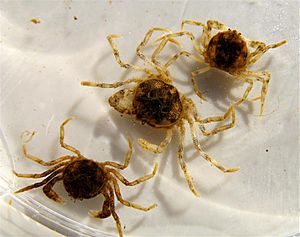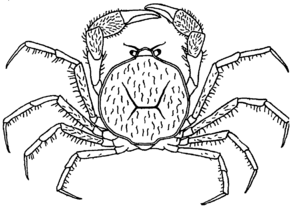Amarinus lacustris facts for kids
Quick facts for kids Amarinus lacustris |
|
|---|---|
 |
|
| Scientific classification | |
| Kingdom: | |
| Phylum: | |
| Subphylum: | |
| Class: | |
| Order: | |
| Infraorder: | |
| Family: |
Hymenosomatidae
|
| Genus: |
Amarinus
|
| Species: |
A. lacustris
|
| Binomial name | |
| Amarinus lacustris (Chilton, 1882)
|
|
| Synonyms | |
|
|
Amarinus lacustris is a special type of crab that lives in freshwater. You can find it in Australia, New Zealand, and some nearby islands. This crab can live in water with different amounts of salt.
It's quite small, growing up to about 10 millimeters (which is 1 centimeter) wide. It has a cool H-shaped groove on its back. This crab eats both plants and animals, making it an omnivore. Bigger animals like crayfish and fish sometimes eat it. This little crab was first found in Lake Pupuke near Auckland. It's the only freshwater crab you'll find in New Zealand!
Contents
Where Does Amarinus lacustris Live?
This freshwater crab, A. lacustris, is found in many places. In south-eastern Australia, it lives from Tasmania all the way up to the Murray-Darling Basin. You can also find it in South Australia and Victoria. It even lives far inland, like in Lake Colac in Victoria.
In New Zealand, A. lacustris is the only freshwater crab. It makes its home in different watery places. These include lakes, slow-moving streams, and larger rivers. You can find it from the lower parts of the Waikato River up to the Northland area. There's a well-known group of them in the Oratia Stream near Auckland.
This crab also lives on small islands in the Tasman Sea. These islands include Lord Howe Island and Norfolk Island. On Norfolk Island, it was first found high up on Mount Gower.
What Does Amarinus lacustris Look Like?
The A. lacustris crab can grow up to 10 millimeters (1 centimeter) across its carapace (which is its hard upper shell). Its legs can spread out to about 20 millimeters wide. The carapace is usually grey-brown and almost round. It has special grooves that look like an H-shape on its back. The whole crab is covered in tiny hairs called setae.
There's a very similar crab called A. paralacustris. Scientists realized it was a different species in 1970. It's hard to tell these two crabs apart unless they are adult females. The main difference is how their babies grow. A. lacustris has "direct development." This means the baby crabs hatch looking like tiny adults. They don't have free-swimming larval stages.
On the other hand, A. paralacustris has "indirect development." Its babies go through free-swimming larval stages. For A. lacustris, the mother crab carries her tiny hatchlings under her tail. She keeps them safe until they are big enough to find their own food.
How Does Amarinus lacustris Live?
A. lacustris lives in places where rivers meet the sea (estuaries), in freshwater, and in shallow areas of the ocean floor. It usually prefers water with a low amount of salt, between 1 and 6 parts per thousand. Sometimes, it can live in water with even less salt or a bit more.
You can often find these crabs hiding among dead leaves and plants. They like the shady edges of rivers and lakes. Scientists have looked at what's inside the stomachs of A. lacustris. They found bits of both animals and plants. This shows that the crab is an omnivore, meaning it eats both meat and plants. Some animals that eat A. lacustris include crayfish and trout (a type of fish that was brought to these areas).
The History of Amarinus lacustris's Name
The A. lacustris crab was first described in 1882. A scientist named Charles Chilton gave it the name Elamena lacustris. He found a single young female crab in Lake Pupuke on New Zealand's North Island.
Later, this crab was moved to different groups of crabs. It was called Hymenosoma and then Halicarcinus. Finally, in 1980, scientists created a new group just for it, called Amarinus. The name amarinus comes from Latin and means "not the sea." This makes sense because it's a freshwater crab! The second part of its name, lacustris, also comes from Latin and means "of lakes." So, its name basically means "not from the sea, but from lakes."
See Also
- Amarinus lacustris discussed on RNZ Critter of the Week, 15 June 2018
- Amarinus lacustris life stages photography at Aquarzon


